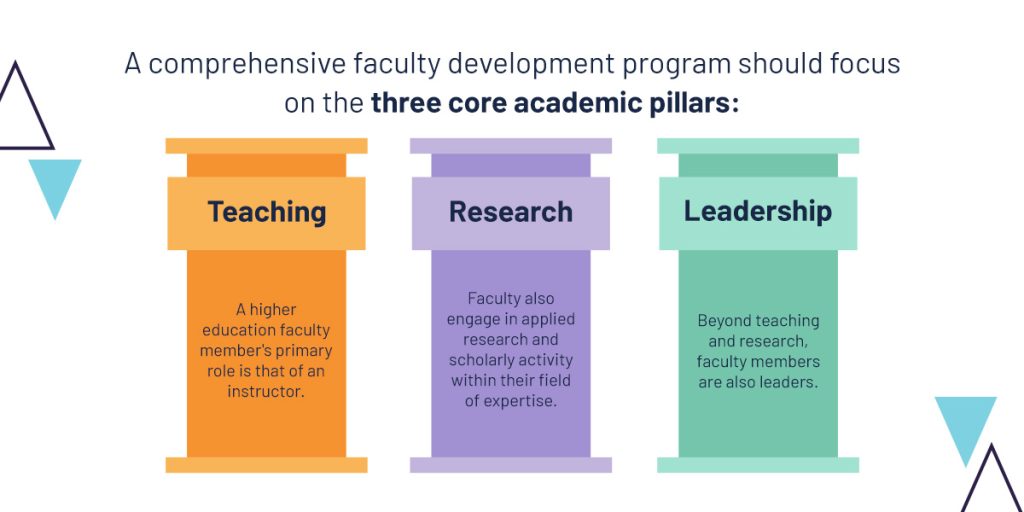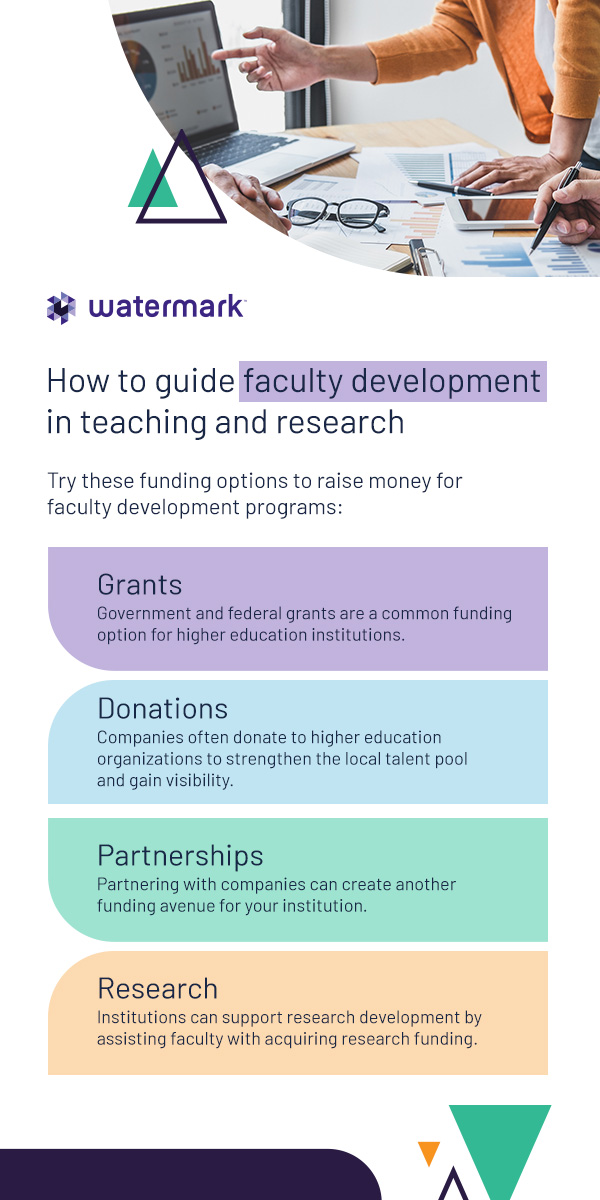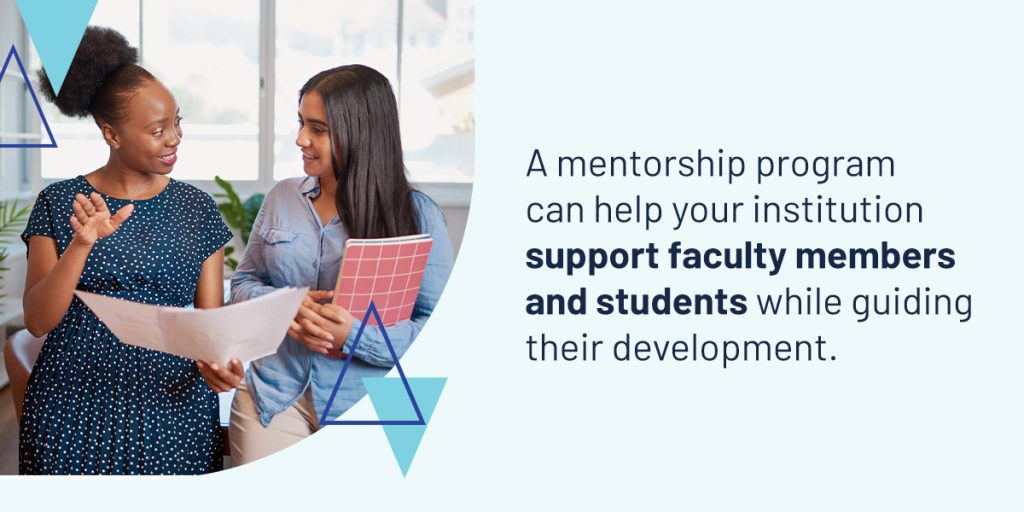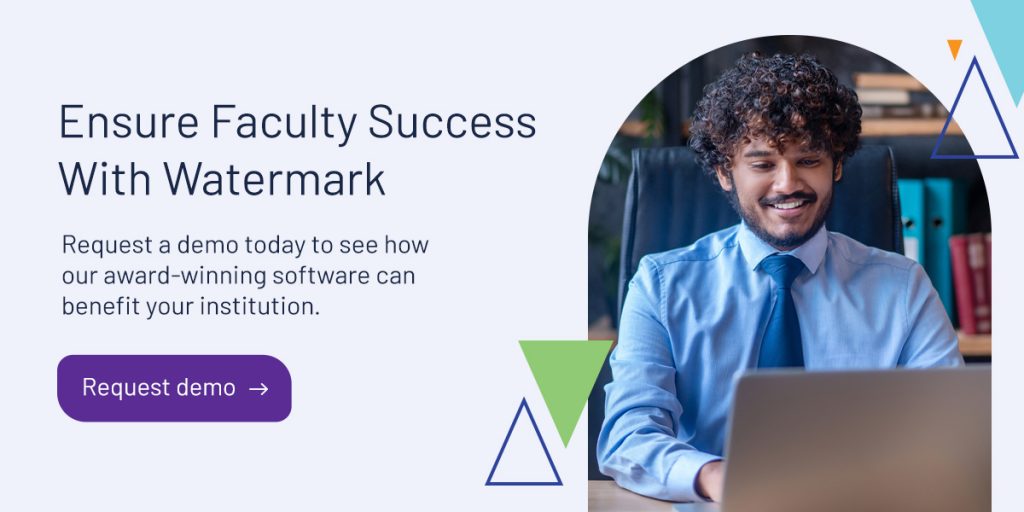




Student performance is imperative for success in higher education — when students do well, it reflects positively on the whole institution. Investing in faculty development is one of the best strategies for achieving better student outcomes. Faculty development refers to initiatives that guide faculty members toward gaining new knowledge and skills within their roles, which often encompass both teaching and research.
By balancing development initiatives and growth in both areas, you can encourage continual growth, improve job satisfaction, and retain staff. This guide offers advice and techniques for creating a balanced faculty development program to help you set your faculty, students, and institution up for success.
How happy and engaged faculty are in their positions can impact how well students perform. Professors interact directly with students to teach and guide them through their coursework. When faculty actively work to deliver quality education and connect with students, they’ll create an enriching learning environment where students can succeed.
This concept is called faculty engagement. An engaged faculty member is satisfied with their work and wants to better themselves, their students, and the institution as a whole. However, keeping faculty engaged is challenging without the right strategy. Many factors influence faculty engagement, including:
Investing in faculty development can target many of these areas by helping faculty achieve their professional goals. By supporting their development in both teaching and research, you can give faculty the tools they need to succeed. Doing so can improve student outcomes and boost your institution’s reputation.
A faculty development program is a tool you can leverage to support faculty success and, consequently, student and institutional success. Many higher education institutions focus programs solely on educational development, as it’s the skill set that affects students the most. However, faculty play more than one role within an organization. Creating a program that reflects all faculty skills creates well-rounded, successful individuals who are an asset to higher education institutions.
A comprehensive faculty development program should focus on the three core academic pillars:

While higher education organizations widely regard faculty development as beneficial for educational quality and academic excellence, various challenges can hinder its effectiveness. Being aware of these challenges can help you address them proactively to ensure the effectiveness of your institution’s development programs.
Common challenges with implementing faculty development programs include:
Use the techniques below to overcome common faculty development challenges and support faculty in all their endeavors.
Funding is an issue for many higher education institutions, especially as student enrollment rates decline. To combat budget constraints, your institution can seek funding from additional sources. Diversifying your funding pool can help stabilize your institution’s income stream and form a budget for faculty development.

Try these funding options to raise money for faculty development programs:
A lack of faculty enthusiasm and motivation can hinder development initiatives. Often, their unwillingness is due to a lack of understanding, relevance, support, and incentive. How will the development activities benefit them? Take the time to explain your institution’s development goals to faculty and highlight the benefits of their involvement.
Benefits can include improvements to teaching practices, student outcomes, career progression, recognition, and personal growth. While many faculty members love learning, better reasoning and incentives can help them prioritize participation in development activities.
The success of your development initiatives lies in faculty involvement in the planning process. Including faculty in the design and planning phases will ensure the program meets their unique needs and circumstances. This strategy will also ensure that development activities are relevant to staff and provide them with skills that will have the most impact on their lives.
An easy way to involve faculty in planning is to conduct focus groups and interviews. Recruit faculty from various departments and backgrounds and engage in in-depth discussions about their needs and preferences. You can gather their opinions about development program schedules, formats, content, and delivery methods. During conversations, create a welcoming environment where faculty can open up and share their feelings. You may uncover some key insights into their needs that can help you craft a more effective program.
Without the right facilities and equipment, faculty may be unable to implement what they learn in development courses. You can support faculty development by updating campus buildings and investing in new technology. The latest tools and techniques can help them stay ahead of trends and provide students with a competitive education. Updated equipment can also help faculty conduct innovative research and achieve their professional goals.
Before implementing anything new, it’s essential to have a change management plan in place. New technology or equipment can disrupt teaching and research if faculty don’t know how to use it. Spend time getting faculty on board with the change and create an implementation plan and timeline. With proper training and a clear strategy, changing to new systems can be seamless and even exciting.
Workshops are an effective addition to faculty development programs. A training workshop is an interactive group learning session. Rather than passively listening to a lecture or reading course content, faculty participate in activities and discussions to enhance learning and understanding. It’s a collaborative process that can improve faculty relationships while teaching new skills.
Work with faculty to develop a workshop schedule for the year, using dates and times that most of the team can attend. You can also gather ideas from faculty for course content or even request a faculty member to host the workshop. Create a summary or record the session to give to anyone who can’t attend. Creating a follow-up activity — like a questionnaire or meeting — is also beneficial for discussing how faculty have implemented the ideas they learned.

A mentorship program can help your institution support faculty members and students while guiding their development. Start by pairing committed senior mentors with recent hires. Guidance and support from existing faculty can help new members acclimate to their roles and learn about the institution’s culture. Mentorship also benefits all faculty members working toward developmental goals in teaching and research. Their mentor’s expertise and experience can fast-track their learning and give them the support they need to flourish.
You can also encourage faculty to mentor students. Students gain valuable skills from their mentors and learn how to succeed academically and in their future careers. Mentors benefit from mentoring faculty and students, as they’ll learn leadership and communication skills. Plus, it can be a rewarding experience when mentors receive sufficient recognition for their work.
You can increase mentorship effectiveness by enrolling faculty in mentorship training, where they’ll learn how to:
Faculty have to complete many administrative tasks as part of their daily responsibilities and service duties. These tasks often take them away from teaching or research and can be time-intensive. This is especially true if they’re working with outdated systems that slow the process and make tasks more complex than needed.
Implementing practical digital tools and software can decrease or remove the administrative burden for faculty. Reducing manual work and speeding up processes through digitization can be a game-changer for faculty productivity and job satisfaction. They’ll also have more time to focus on their core responsibilities and goals.
Another way to support faculty development is to communicate with faculty members frequently. Proactive communication can help you gather feedback and address issues as they arise. Their feedback can help you tailor future development initiatives to meet their needs.
Schedule regular check-ins with staff to set goals and gather their feedback. These check-ins show staff that you care about their growth and want to help them succeed. A yearly review is also beneficial to analyze their performance and provide constructive criticism and recommendations for improvement. If faculty members raise any concerns, follow up with solutions that address them. The key is to keep communication transparent and consistent both ways.
Often, asking faculty members to engage in development activities during their busy schedules can be met with reluctance. Adding to their heavy workloads can increase stress and affect their work-life balance. Providing faculty with incentives and rewards for partaking in development activities can increase their motivation and satisfaction.
Incentives come in many forms, and you can work within your institution’s budget and staff preferences to determine the best types. After all, what motivates one employee may not work for another. Consider offering monetary stipends to faculty for completing courses or training. Rewards can also come in the form of new equipment and devices. You can incorporate learning participation into promotion requirements and recognize staff for their dedication to professional development.
Finally, the last component of faculty development is evaluation. Higher education administrators must collect data and feedback from all developmental activities to analyze its effectiveness. Without this data, it’s hard to prove the impact development programs have on faculty performance and job satisfaction.
Track all developmental initiatives and gather data through assessments, feedback, and achievements. Once you have enough data, you can organize it and look for patterns and actionable findings called insights. Use these insights to inform decision-making and improve future faculty development programs. Consistent evaluation and adaptation can help you support faculty in the long term.
At Watermark, we believe that the right data can help your institution support faculty growth. That’s why we created Watermark Faculty Success — an innovative software that acts as a central hub for all faculty activity data. It helps faculty save time with activity reporting while allowing you to gain deeper insights into their contributions.
Faculty Success facilitates the faculty review process, allowing you to recognize faculty accomplishments and support their professional growth. The software can also automatically update faculty web profiles and simplify complex processes like self-studies and accreditation reports. Faculty Success will give you the tools to help your faculty grow and thrive.
Request a demo today to see how our award-winning software can benefit your institution.






























































































































































































































































































































































































